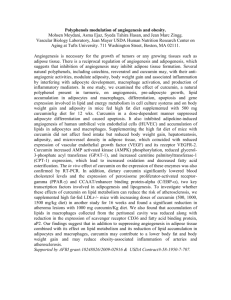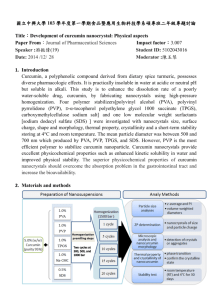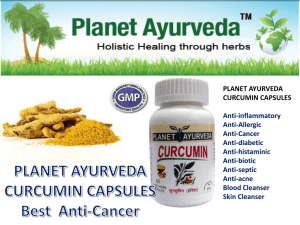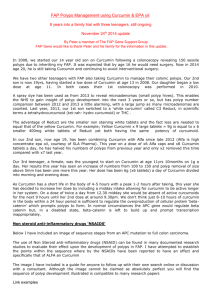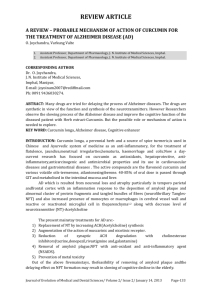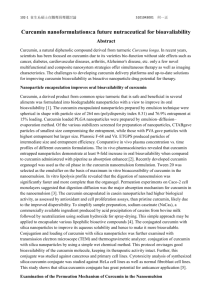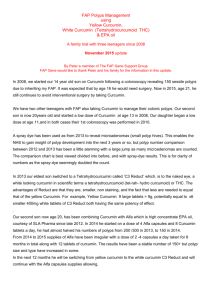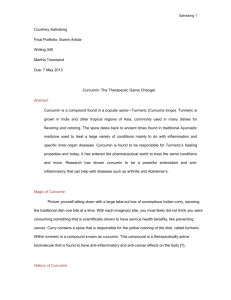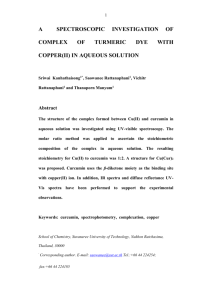Seminar On Food Science And Biotechnology Graduate Institute In
advertisement
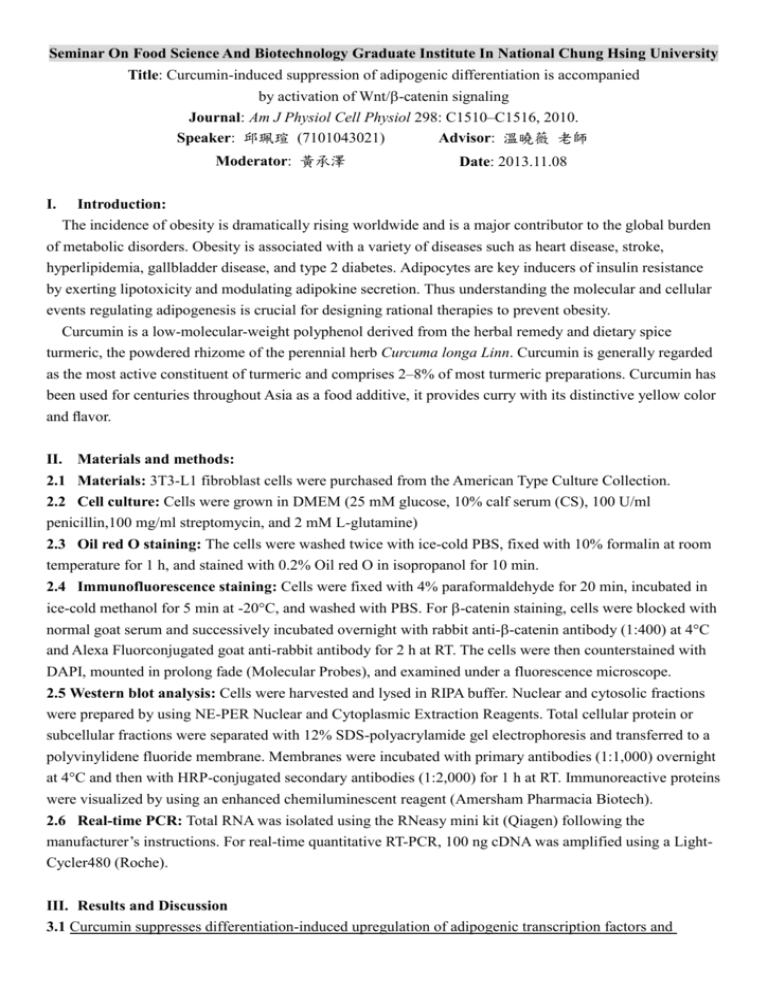
Seminar On Food Science And Biotechnology Graduate Institute In National Chung Hsing University Title: Curcumin-induced suppression of adipogenic differentiation is accompanied by activation of Wnt/-catenin signaling Journal: Am J Physiol Cell Physiol 298: C1510–C1516, 2010. Speaker: 邱珮瑄 (7101043021) Advisor: 溫曉薇 老師 Moderator: 黃承澤 Date: 2013.11.08 I. Introduction: The incidence of obesity is dramatically rising worldwide and is a major contributor to the global burden of metabolic disorders. Obesity is associated with a variety of diseases such as heart disease, stroke, hyperlipidemia, gallbladder disease, and type 2 diabetes. Adipocytes are key inducers of insulin resistance by exerting lipotoxicity and modulating adipokine secretion. Thus understanding the molecular and cellular events regulating adipogenesis is crucial for designing rational therapies to prevent obesity. Curcumin is a low-molecular-weight polyphenol derived from the herbal remedy and dietary spice turmeric, the powdered rhizome of the perennial herb Curcuma longa Linn. Curcumin is generally regarded as the most active constituent of turmeric and comprises 2–8% of most turmeric preparations. Curcumin has been used for centuries throughout Asia as a food additive, it provides curry with its distinctive yellow color and flavor. II. Materials and methods: 2.1 Materials: 3T3-L1 fibroblast cells were purchased from the American Type Culture Collection. 2.2 Cell culture: Cells were grown in DMEM (25 mM glucose, 10% calf serum (CS), 100 U/ml penicillin,100 mg/ml streptomycin, and 2 mM L-glutamine) 2.3 Oil red O staining: The cells were washed twice with ice-cold PBS, fixed with 10% formalin at room temperature for 1 h, and stained with 0.2% Oil red O in isopropanol for 10 min. 2.4 Immunofluorescence staining: Cells were fixed with 4% paraformaldehyde for 20 min, incubated in ice-cold methanol for 5 min at -20°C, and washed with PBS. For -catenin staining, cells were blocked with normal goat serum and successively incubated overnight with rabbit anti--catenin antibody (1:400) at 4°C and Alexa Fluorconjugated goat anti-rabbit antibody for 2 h at RT. The cells were then counterstained with DAPI, mounted in prolong fade (Molecular Probes), and examined under a fluorescence microscope. 2.5 Western blot analysis: Cells were harvested and lysed in RIPA buffer. Nuclear and cytosolic fractions were prepared by using NE-PER Nuclear and Cytoplasmic Extraction Reagents. Total cellular protein or subcellular fractions were separated with 12% SDS-polyacrylamide gel electrophoresis and transferred to a polyvinylidene fluoride membrane. Membranes were incubated with primary antibodies (1:1,000) overnight at 4°C and then with HRP-conjugated secondary antibodies (1:2,000) for 1 h at RT. Immunoreactive proteins were visualized by using an enhanced chemiluminescent reagent (Amersham Pharmacia Biotech). 2.6 Real-time PCR: Total RNA was isolated using the RNeasy mini kit (Qiagen) following the manufacturer’s instructions. For real-time quantitative RT-PCR, 100 ng cDNA was amplified using a LightCycler480 (Roche). III. Results and Discussion 3.1 Curcumin suppresses differentiation-induced upregulation of adipogenic transcription factors and inhibits adipogenesis. Oil red O staining revealed that treating 3T3-L1 fibroblasts with 25M curcumin completely blocked differentiation. Quantification of Oil red O consistently showed that the lipid accumulation resulting from adipocyte differentiation was significantly reduced in the presence of curcumin. Curcumin inhibited the induction of the master adipogenic transcription factors C/EBP and PPAR 3.2 Curcumin attenuates MAPK (ERK1/2, JNK, and p38) phosphorylation. Dephosphorylation of MAPKs was observed in adipocytes differentiated in the presence of curcumin. The ability of curcumin to modulate the MAPK signaling pathway may explain, at least partly, the anti-adipogenic effects of this compound. Curcumin is known to inhibit MAPK activation. 3.3 Curcumin induces -catenin translocation. Immunofluorescence labeling revealed that in undifferentiated 3T3-L1 cells, -catenin was distributed throughout the cytoplasm and nuclei. However, in differentiated adipocytes, -catenin was localized mainly in the cytoplasm. Importantly, treatment of these cells with curcumin restored the nuclear localization of-catenin. Western blot analysis also revealed that differentiation was associated with a decrease in both nuclear and cytosolic -catenin levels. 3.4 Curcumin activates Wnt signaling. Upon stimulation of 3T3-L1 cell differentiation, the expression of GSK-3, CK1, and Axin was increased. This result is consistent with Wnt signaling suppression, which leads to GSK-3 phosphorylation of -catenin and ubiquitin-mediated degradation of -catenin in differentiated adipocytes. Importantly, curcumin inhibited differentiation-induced expression of GSK-3, CK1, and Axin. Because the activities of GSK-3 and Axin are inhibited when Wnt signaling is active, these data suggest that curcumin activates Wnt signaling in 3T3-L1 cells. 3.5 Curcumin increased the expression of c-Myc and cyclin D1. The mRNA expression of c-Myc and cyclin D1 was reduced in differentiated adipocytes. However, curcumin increased the mRNA expression of these factors. IV. Conclusion Dephosphorylation of MAPKs may participate in the anti-adipogenic effects of curcumin. Curcumin also inhibited the induction of adipogenic transcription factors such as PPARand C/EBP. Wnt/-catenin signaling pathway plays a crucial role in curcumin induced suppression of adipogenesis. V. References 1. Odell ID and Cook D. (2013) Immunofluorescence Techniques. J Invest Dermatol 133: e4. 2. Gehart H, Kumpf S, Ittner A, Ricci R. (2010) MAPK signalling in cellular metabolism: stress or wellness? EMBO reports 11:834–840. 3. Alappat L and Awad AB. (2010) Curcumin and obesity: evidence and mechanisms. Nutr Rev 68:729–738. 4. Ahn J, Lee H, Kim S, Ha T. (2010) Curcumin-induced suppression of adipogenic differentiation is 5. accompanied by activation of Wnt/-catenin signaling. Am J Physiol Cell Physiol 298: C1510–6. Prestwich TC, MacDougald OA. (2007) Wnt/-catenin signaling in adipogenesis and metabolism. Current Opinion in Cell Biology 19:612–617.
